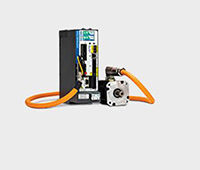Off-axis rotary software for the XR20-W rotary axis calibrator checks the alignment and positioning performance of machine tool rotary axes. The software allows the XR20-W to be used to measure the rotary positioning accuracy of an axis on many configurations of five axis machine tools, where the calibrator often cannot be mounted on the center of rotation. Combined with the AxiSet Check-Up system, which provides machine users with a fast and accurate health check of rotary axis and pivot points, users have comprehensive tools to identify errors with their rotary axes.
The rotary axis calibrator combines with the XL-80 laser interferometer to allow rotary axis positioning performance to be measured with ± 1 arc sec accuracy. With this “off axis” test capability, users can test more types of machine tools.

The method for off axis measurement works by synchronizing movement of rotary and linear axes so that the XL-80’s laser beam is kept aligned throughout the test. Because the linear axis is moving, the measurements made by the XR20-W may include additional angular errors (such as pitch) from the linear axis. These contributory angular errors are then measured separately (using the XL-80 laser and angular optics) and removed from the initial rotary axis results. The end result is a set of data reflecting only the errors from the rotary axis itself.
The off axis rotary software is provided as an extra cost option for XR20-W and includes a suite of software utilities, part program generators and an electronic format manual. The manual details all the requirements for the mounting set-up and associated custom hardware manufacture.
Key to precision machining is the ability to understand the location of the centers of rotations of the rotary axes relative to the machine’s linear axes. Without accurate data about these ‘pivot points,’ a machine’s controller will be unable to reliably control the relative positions of the tool and the component as the rotary axes are moving, leading to inconsistent machining results.
The AxiSet Check-up provides accurate and repeatable results using automated probing routines to gather performance data from a reference artifact, and includes simple yet powerful analysis. Alignment and positioning performance checks are carried out rapidly to benchmark and monitor complex machines over time. All tests use existing spindle-mounted Renishaw touch probes, with probing routines generated using machine-specific macro software supplied with Check-Up. To ensure the highest accuracy, the use of OMP400 or RMP600 touch probes with patented Rengage strain gauge technology is recommended.
Set-up is fast and simple. To perform the test a user quickly locates a supplied calibration sphere within the machine tool’s working envelope using a magnetic mount. Using the supplied custom macro software, a touch probe is then programmed to automatically take reference measurements around the sphere.
Measurement results from the test are output to a PC and presented in a Microsoft Excel spreadsheet. These include a graphical representation of performance that highlights tracking and centering errors, a function that compares two sets of data from the same machine, a simple ‘pass’ or ‘fail’ test against the user’s pre-defined tolerances, and a history screen that allows comparisons of the performance of rotary axes over time.
To ensure the optimum analysis of rotary axis performance using Check-Up, it is important that the machine’s standard three linear axes are also performing within specification. This should be determined and corrected if necessary using Renishaw’s XL-80 laser calibration system, and then regularly checked using a Renishaw QC20-W ballbar. Together with the XR20-W rotary axis calibrator and AxiSet Check-up these powerful performance testing products combine to ensure that the highest quality parts can be consistently produced by five axis machining centers and multi-tasking machines.
Renishaw
www.renishaw.com
Filed Under: Machine tools + subtractive manufacturing, MOTION CONTROL, MORE INDUSTRIES





Tell Us What You Think!